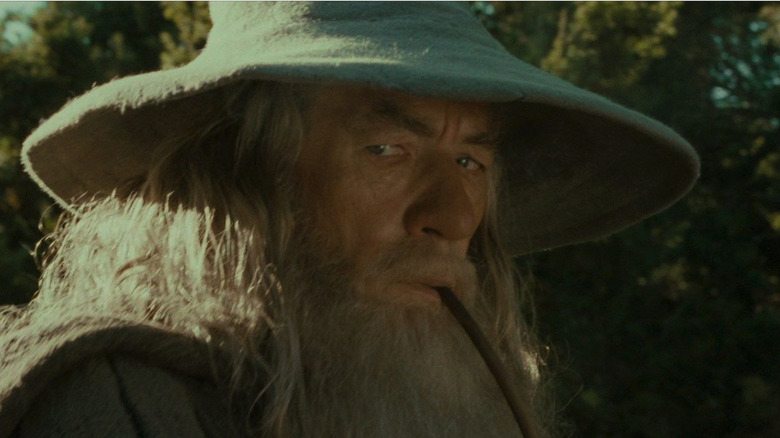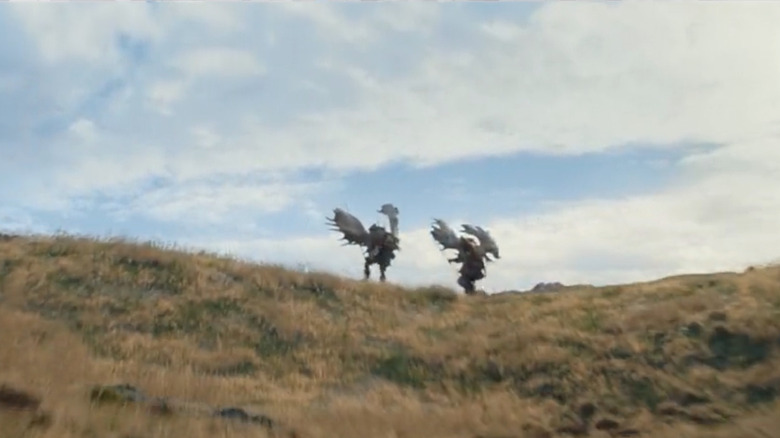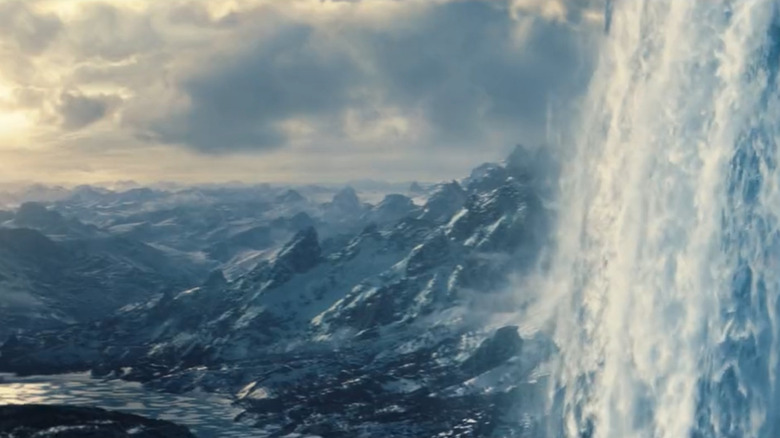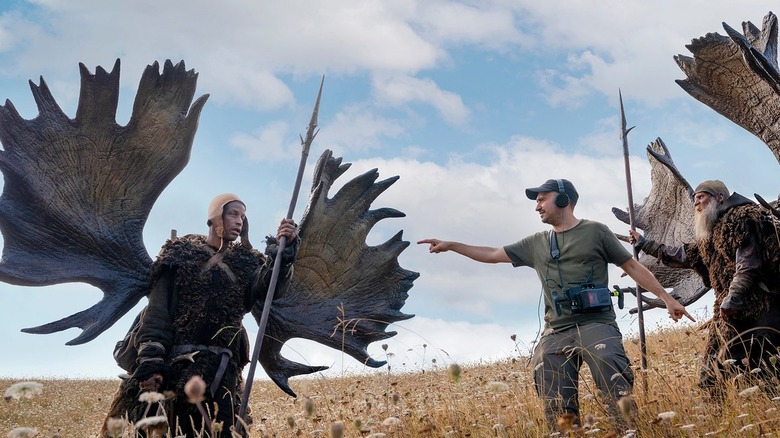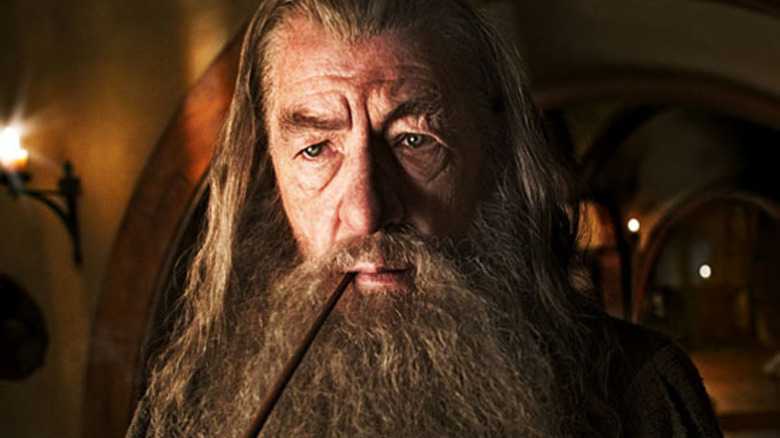Who Are The Wanderers In The Lord Of The Rings: The Rings Of Power Trailer?
"The Lord of the Rings: The Rings of Power" had a massive amount of promotional material dropped over early February. This culminated in the grand reveal of the show's first-ever full-length trailer, which aired during the Super Bowl. Many of the elements in this trailer were recognizable on sight, from the island kingdom of Númenor to Elven and Dwarven conclaves to new-yet-familiar faces, like those of the younger, recast Elrond and Galadriel. Of course, the trailer also had a plethora of mysterious, odd new additions. We see a terrifying troll-like creature, we meet the Silvan elf Arondir, and we witness a mysterious fireball-of-a-man emerging from some Cracks-of-Doom style wreckage.
We also see two men walking around with what appear to be huge antlers strapped to their backs. The look is impressive, and it gives the two characters an imposing appearance as they make their way across a gorgeous Middle-earth landscape. This isn't the first time we've seen these wanderers, either. In Vanity Fair's behind-the-scene info dump in the week leading up to the trailer reveal, a picture was also shown of director J.A. Bayona directing the two unknown individuals.
While most of the other unknown elements of the trailer seem likely to have very specific hidden meanings, these two nomads remain an enigma. Their puzzling appearance in multiple areas of the show's promotional material — including its first character posters released in early February — seems to point to the fact that they at least have some role to play, and their continued presence has gotten fans speculating as to who they could be.
After the pair have made so many appearances so close together, we've decided to get in on the action, too. Here are some of Looper's best guesses regarding who these mysterious wanderers could be.
Maybe they're nobody after all?
We have to start with the obvious. On the surface, these two travelers have no distinct connection to any part of Tolkien's Middle-earth story. Their odd combination of angelic wings and rough clothing don't point to any particular Middle-earth people group. Their wandering antics could fall in line with just another one of the many migrating tribes of Men that Tolkien repeatedly references throughout his material. These tribes are usually located along the eastern and southern portions of the map, and many of them are particularly busy moving west during the earlier eras of Tolkien's world.
Vanity Fair (whose staff claimed to have already seen the first three episodes before the initial trailer even aired) describes these odd newcomers as "two human hunter-gatherers" and "two nomadic hunters wandering the fields of Middle-earth." VF also claims that the characters are "not particularly central to the story" and that they're merely included to help with things like world-building. While it isn't clear if their statements are backed by Amazon Studio's seal of approval, if the characters are little more than anonymous wanderers, it would make sense that they'd use them to set the tone for the show, especially if they don't want to use too much important footage too early in the promotional cycle.
That said, the idea that they're little more than a plot device to show off the world is a bit boring. So, let's go a little further afield with the speculation, shall we?
Could they be members of the Forodwaith?
If we had to peg a specific people group of Middle-earth for these two wanderers, there are a couple of tribes of men that come to mind. One of those is the Forodwaith. In "The Return of the King" these are called "Men of far-off days." In the Third Age, their descendants, known as the Lossoth or "the Snowmen," continue to live way in the north of Middle-earth, where the winter is bitter cold. Much like Hobbits, the earlier history of these men is unknown, but that obviously hasn't stopped Amazon from creating backstories for its characters and cultures so far.
In their homeland, the Lossoth dwell in the snow. It literally says in the text that they "house in the snow, and it is said that they can run on the ice with bones on their feet, and have carts without wheels."
While the Lossoth (and, assuming by extension, their ancestors) are generally isolationists, they're also described as a "strange, unfriendly people," which matches the description of these two fellows well enough. They also live a primitive lifestyle. They don't value jewels and are intimidated by the weapons of other nations. Again, these wanderers with simple spears, antler-like backpacks, and warm-looking rags could easily be nomads who decided to leave their snow huts in the north and make their way into the warmer regions of the south.
Another possible connection is the region of their homeland. The Forodwaith live in the land of the same name, the Forodwaith or "Northern Waste." This is a bitterly cold area of the map that has likely already been shown in the trailer when Galadriel is depicted climbing a frozen cliff. Perhaps the two wanderers and Galadriel's excursion north will overlap in some way.
Perhaps they're the Blue Wizards?
All right, now that we've got the rational guesses out of the way, it's time to dive in and have some more speculative fun. One guess that we absolutely have to include here is the Blue Wizards. And yes, we understand that these characters aren't actively wearing blue in the scenes that we've been shown... but hear us out.
The first question has to be timing. Many people are aware of the fact that the wizards come a thousand years into the Third Age. However, in the book "The Peoples of Middle-earth," one of the last versions of the Blue Wizards' story that we get explains that they may have actually been sent along with the Elf-hero Glorfindel "when matters became very dangerous in the Second Age."
In this version, the wizards remain good (in earlier versions they are corrupted) and it says that they are called Morinehtar and Rómestámo, which mean Darkness-slayer and East-helper, respectively. It adds that "their task was to circumvent Sauron: to bring help to the few tribes of Men that had rebelled from Melkor-worship, to stir up rebellion..." As a final punchy finish, it explains that "They must have had very great influence on the history of the Second Age and Third Age in weakening and disarraying the forces of East..."
As far as their non-blue garb goes, the wizards don't always go around showing off their Istari colors. A good example of this takes place when Gandalf the White first reappears in "The Two Towers." In the books, he's wearing old rags with his white robes hidden underneath. Perhaps these two wanderers simply have some local garments on over an azure underlayer. Is it far-fetched? Maybe. Is it possible, though? Seems so to us.
Is one of them Gandalf?
If the Blue Wizards wasn't enough of a reach, it's possible to speculate that one of the wanderers could actually be Gandalf — or at least, Olórin, the Maiar spirit that becomes Gandalf the wizard later on. Now, to be fair, the line of reasoning here is a bit dicey. Some have guessed that the hand seen at the end of the trailer is Olórin, and it looks very much so like that appendage and its clothing belong to the older of the two wanderers or someone very similar in looks and clothing.
Unlike the Blue Wizard's, Gandalf's place in Tolkien's lore seems definitely set in the Third Age, making an appearance by the wizard himself about as difficult to fit in as, oh, say a Hobbit (even though they are managing to do that one, too, via the show's proto-Hobbit Harfoots.) However, before Gandalf is packed up in a mortal old-man body and sent to help resist Sauron, he's one of the angelic Maiar. These creatures mostly live across the sea in the Blessed Realm in the West. However, some are known to take mortal forms and spend time in Middle-earth, as well. Perhaps the most famous of these is queen Melian, who is a major character in the First Age of Middle-earth history.
In "The Silmarillion" it explains that Olórin loved the Elves and "walked among them unseen, or in form as one of them, and they did not know whence came the fair visions or the promptings of wisdom that he put into their hearts." It also adds that "In later days he was the friend of all the Children of Ilúvatar, and took pity on their sorrows..."
So yeah, while it would definitely involve connecting a lot of dots, it's at least plausible that this character (or any of the new characters, really) could be Olórin in disguise before he's put into a semi-permanent, incarnate wizard body in the Third Age.
